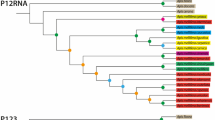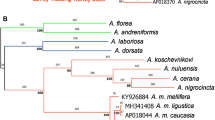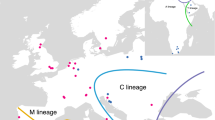Abstract
NON-INDIGENOUS African honey bees have invaded most of South and Central America in just over 30 years1. The genetic composition of this population and the means by which it rapidly colonizes new territory remain controversial. In particular, it has been unclear whether this 'Africanized' population has resulted from interbreeding between African and domestic European bees, or is an essentially pure African population. Also, it has not been known whether this population expanded primarily by female or by male migration. Restriction site mapping of 62 mitochondrial DNAs of African bees from Brazil, Venezuela and Mexico reveals that 97% were of African (Apis mellifera scutellata) type. Although neotropical European apiary populations are rapidly Africanized by mating with neotropical African males, there is little reciprocal gene flow to the neotropical African population through European females. These are the first genetic data to indicate that the neotropical African population could be expanding its range by female migration.
This is a preview of subscription content, access via your institution
Access options
Subscribe to this journal
Receive 51 print issues and online access
$199.00 per year
only $3.90 per issue
Buy this article
- Purchase on Springer Link
- Instant access to full article PDF
Prices may be subject to local taxes which are calculated during checkout
Similar content being viewed by others
References
Taylor, O. R. in Africanized Honey Bees and Bee Mites (eds Needham, G. R., Page, R. E. Jr, Pelfinado–Baker, M. & Bowman, C.) 29–41 (Ellis Horwood, Chichester, 1988).
Ruttner, F. Biogeography and Taxonomy of Honey Bees (Springer, Berlin, 1988).
Morse, R. A., Burgett, D., Ambrose, J. T., Conner, W. E. & Fell, R. D. See World 54, 57–60 (1975).
Oertel, E. Am. Bee J. 116, 70–71; 114; 128; 156–57; 214–15; 260–61; 290 (1976).
Pellet, F. C. History of American Bee-keeping. (Collegiate, Ames, 1930).
Kerr, W. E. S. Afr. Bee J. 39, 3–5 (1967).
Rinderer, T. Bull. ent. Soc. Am. 32, 222; 224; 226–227 (1986).
Taylor, O. R. Bee World 58, 19–30 (1977).
Rinderer, T. in Africanized Honey Bees and Bee Mites (eds Needham, G. R., Page, R. E. Jr, Delfinado-Baker, M. & Bowman, C.) 13–27 (Ellis Horwood, Chichester, 1988).
Rinderer, T. Am. Bee J. 126, 98–100; 128–129 (1986).
Collins, A., Rinderer, T., Harbo, J. & Bolten, A. Science 218, 72–74 (1982).
Taylor, O. R. Bull. ent. Soc. Am. 34, 15–24 (1985).
Michener, C. D. A. Rev. Ent. 20, 399–416 (1975).
Winston, M. L., Dropkin, J. A. & Taylor, O. R. Oecologia 48, 407–413 (1981).
Winston, M. L., Otis, G. W. & Taylor, O. R. J. apic. Res. 18, 85–94 (1979).
Daly, H. & Balling, S. S. J. Kans. ent. Soc. 51, 857–869 (1978).
Nunamaker, R. A. & Wilson, W. T. J. Kans. ent. Soc. 54, 704–710 (1981).
Sylvester, H. A. J. apic. Res. 21, 93–97 (1982).
Hall, H. G. Proc. natn. Acad. Sci. U.S.A. 83, 4874 (1986).
Hall, H. G. in Africanized Honey Bees and Bee Mites (eds Needham, G. R., Page, R. E. Jr, Delfinado-Baker, M. & Bowman, C.) 287–293 (Ellis Horwood, Chichester, 1988).
Rinderer, T., Hellmich II, R. L., Danka, R. G. & Collins, A. Science 228, 1119–1121 (1985).
Taylor, O. R. Am. Bee J. 125, 586–587 (1985).
Otis, G. W. in Social Insects in the Tropics (ed. Jaisson, P.) 209–219 (Universite Paris-Nord, 1982).
Winston, M. L. Behav. Ecol. Sociobiol. 4, 279–292 (1979).
Winston, M. L. in Africanized Honey Bees and Bee Mites (eds Needham, G. R., Page, R. E. Jr, Delfinado-Baker, M. & Bowman, C.) 136–140 (Ellis Horwood, Chichester, 1988).
Otis, G. W., Winston, M. L. & Taylor, O. R. J. apic. Res. 20, 3–12 (1981).
Smith, D. R. in Africanized Honey Bees and Bee Mites (eds Needham, G. R., Page, R. E. Jr. Delfinado-Baker, M. & Bowman, C.) 303–312 (Ellis Horwood, Chichester, 1988).
Smith, D. R. & Brown, W. M. Ann. ent. Soc. Am. (in the press).
Smith, D. R. & Brown, W. M. Experientia 44, 257–260 (1988).
Contel, E. P. B., Mestriner, M. A. & Martins, E. Biochem. Genet. 15, 859–876 (1977).
Spivak, M., Ranker, T., Taylor, O. R., Taylor, W. & Davis, L. in Africanized Honey Bees and Bee Mites (eds Needham, G. R., Page, R. E. Jr, Delfinado-Baker, M. & Bowman, C.) 313–324 (Ellis Horwood, Chichester, 1988).
Del Lama, M. A., Figueiredo, R. A., Soares, A. E. E. & Del Lama, S. N. Rev. Brazil. Genet. 11, 287–297 (1988).
Nei, M. & Tajima, F. Genetics 105, 207–217 (1983).
Sokal, R. R. & Rohlf, F. J. Biometry (Freeman, San Francisco, 1981).
Sheppard, W. S. & Berlocher, S. H. J. Hered. 76, 45–48 (1985).
Sheppard, W. S. Ann. ent. Soc. Am. 81, 886–889 (1988).
Author information
Authors and Affiliations
Rights and permissions
About this article
Cite this article
Smith, D., Taylor, O. & Brown, W. Neotropical Africanized honey bees have African mitochondrial DNA. Nature 339, 213–215 (1989). https://doi.org/10.1038/339213a0
Received:
Accepted:
Issue Date:
DOI: https://doi.org/10.1038/339213a0
This article is cited by
-
High-resolution (mtDNA) melting analysis for simple and efficient characterization of Africanized honey bee Apis mellifera (Hymenoptera:Apidae)
Genetica (2021)
-
Exotic insect pollinators and native pollination systems
Plant Ecology (2021)
-
Influence of reproductive biology on establishment capacity in introduced Hymenoptera species
Biological Invasions (2021)
-
Intentionally introduced terrestrial invertebrates: patterns, risks, and options for management
Biological Invasions (2016)
-
The genetic consequences of the anthropogenic movement of social bees
Insectes Sociaux (2016)
Comments
By submitting a comment you agree to abide by our Terms and Community Guidelines. If you find something abusive or that does not comply with our terms or guidelines please flag it as inappropriate.



